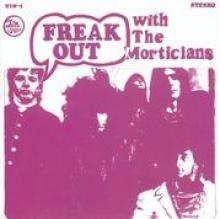Amongst the refuse pile that was the eighties’ psych and garage revival were a handful of notable releases. Of course, anything dug up at this point will unquestionably be lauded as the missing link between those olden days and newer tripped out sounds. The Morticians have probably had all that levied upon it – warranted or not. And while there’s not a good reason to dismiss the band, there’re actually a couple reasons that the group’s 1987 Freak Out with the Morticians should be explored a bit.
Firstly, the album’s cover is an obvious homage to Frank Zappa and the Mothers’ of Invention’s first album. The title’s even basically the same save for band names being swapped in and out. There isn’t anything here making the band as political or social as interesting as Zappa’s troupe, but that can’t be expected from every ensemble.
In keeping with the throw back phenomenon, the Morticians even see fit to include a version of The Litter’s "Action Woman." It’s not a tremendous shock – the song counts as the Litter’s only worthwhile effort – but again works to cement this group’s dedication to dead sounds.
Part of the backwards gaze at psych stuff, the original LP version of Freak Out with the Morticians was split into two distinct sides, each concerning itself with either punk or psych. It’s either a well telegraphed play at appealing to two disparate markets or it’s just a goof. In hearing that first side that’s supposed to be punk related, there’s surely a nasty garage thing going on, but by 1987 there were countless definitions of punk ranging from what’s here to the Exploited and back again.
Of more interest, since that first side’s all short takes on the garage form, is the second half of the album – that pysch stuff. And while there’s no new ground broken here, natch, some of the Morticians’ productions are capacious of surprising listeners.
During “Spiral Bat,” which begins with cribbed Bo Diddley lyrics, the group gets all improvisational on listeners. And while that might not sound too engaging, there’re are enough odd sounds, assumed added in post production, that folks hearing the album might find it necessary to turn the volume down for a moment just to see if the aural theatrics are from the recording or some street hassle outside.
None of this is required listening for the psych and garage traveler, but it is a surprising high point for the mid to late eighties underground music scene.
